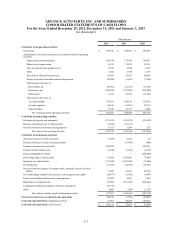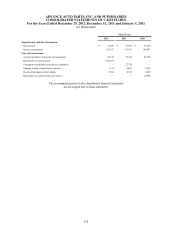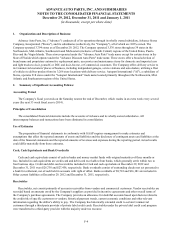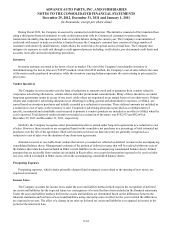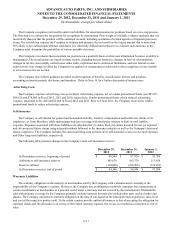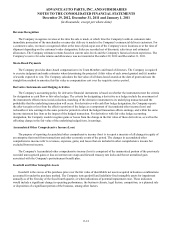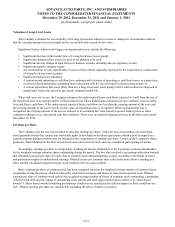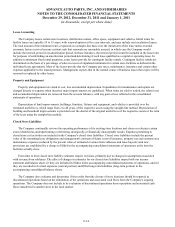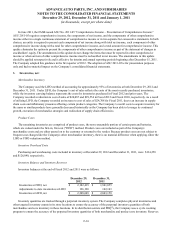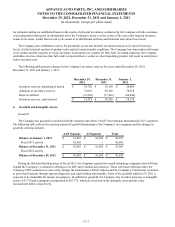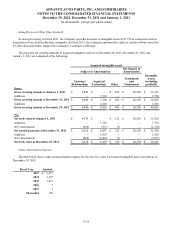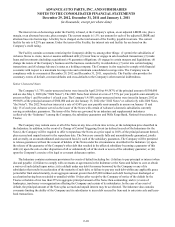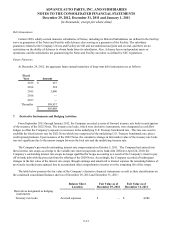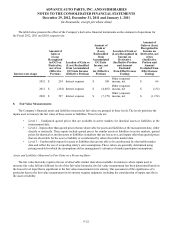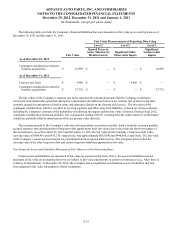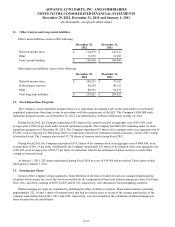Advance Auto Parts 2012 Annual Report Download - page 61
Download and view the complete annual report
Please find page 61 of the 2012 Advance Auto Parts annual report below. You can navigate through the pages in the report by either clicking on the pages listed below, or by using the keyword search tool below to find specific information within the annual report.
F-16
In June 2011, the FASB issued ASU No. 2011-05 “Comprehensive Income – Presentation of Comprehensive Income.”
ASU 2011-05 requires comprehensive income, the components of net income, and the components of other comprehensive
income either in a single continuous statement of comprehensive income or in two separate but consecutive statements. In both
choices, an entity is required to present each component of net income along with total net income, each component of other
comprehensive income along with a total for other comprehensive income, and a total amount for comprehensive income. This
update eliminates the option to present the components of other comprehensive income as part of the statement of changes in
stockholders' equity. The amendments in this update do not change the items that must be reported in other comprehensive
income or when an item of other comprehensive income must be reclassified to net income. The amendments in this update
should be applied retrospectively and is effective for interim and annual reporting periods beginning after December 15, 2011.
The Company adopted this guidance in the first quarter of 2012. The adoption of ASU 2011-05 is for presentation purposes
only and had no material impact on the Company’s consolidated financial statements.
3. Inventories, net:
Merchandise Inventory
The Company used the LIFO method of accounting for approximately 95% of inventories at both December 29, 2012 and
December 31, 2011. Under LIFO, the Company’s cost of sales reflects the costs of the most recently purchased inventories,
while the inventory carrying balance represents the costs for inventories purchased in Fiscal 2012 and prior years. The
Company recorded a reduction to cost of sales of $24,087 and $29,554 in Fiscal 2012 and Fiscal 2010, respectively. As a result
of utilizing LIFO, the Company recorded an increase to cost of sales of $24,708 for Fiscal 2011, due to an increase in supply
chain costs and inflationary pressures affecting certain product categories. The Company’s overall costs to acquire inventory for
the same or similar products have generally decreased historically as the Company has been able to leverage its continued
growth, execution of merchandise strategies and realization of supply chain efficiencies.
Product Cores
The remaining inventories are comprised of product cores, the non-consumable portion of certain parts and batteries,
which are valued under the first-in, first-out ("FIFO") method. Product cores are included as part of the Company's
merchandise costs and are either passed on to the customer or returned to the vendor. Because product cores are not subject to
frequent cost changes like the Company's other merchandise inventory, there is no material difference when applying either the
LIFO or FIFO valuation method.
Inventory Overhead Costs
Purchasing and warehousing costs included in inventory at December 29, 2012 and December 31, 2011, were $134,258
and $126,840, respectively.
Inventory Balance and Inventory Reserves
Inventory balances at the end of Fiscal 2012 and 2011 were as follows:
December 29,
2012
December 31,
2011
Inventories at FIFO, net $ 2,182,419 $ 1,941,055
Adjustments to state inventories at LIFO 126,190 102,103
Inventories at LIFO, net $ 2,308,609 $ 2,043,158
Inventory quantities are tracked through a perpetual inventory system. The Company completes physical inventories and
other targeted inventory counts in its store locations to ensure the accuracy of the perpetual inventory quantities of both
merchandise and core inventory in these locations. In its distribution centers and PDQ®s, the Company uses a cycle counting
program to ensure the accuracy of the perpetual inventory quantities of both merchandise and product core inventory. Reserves
ADVANCE AUTO PARTS, INC. AND SUBSIDIARIES
NOTES TO THE CONSOLIDATED FINANCIAL STATEMENTS
December 29, 2012, December 31, 2011 and January 1, 2011
(in thousands, except per share data)



